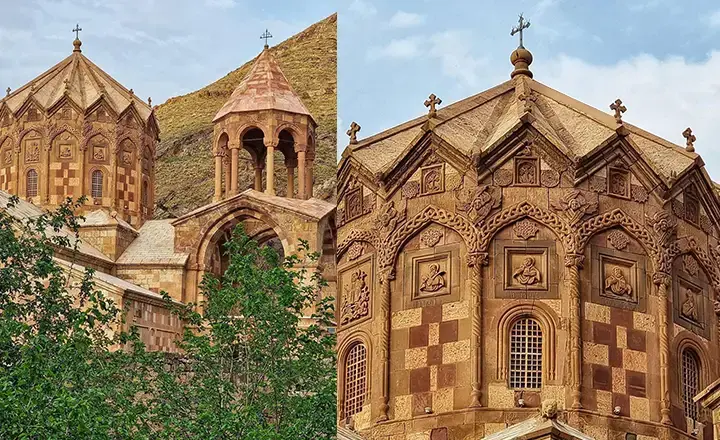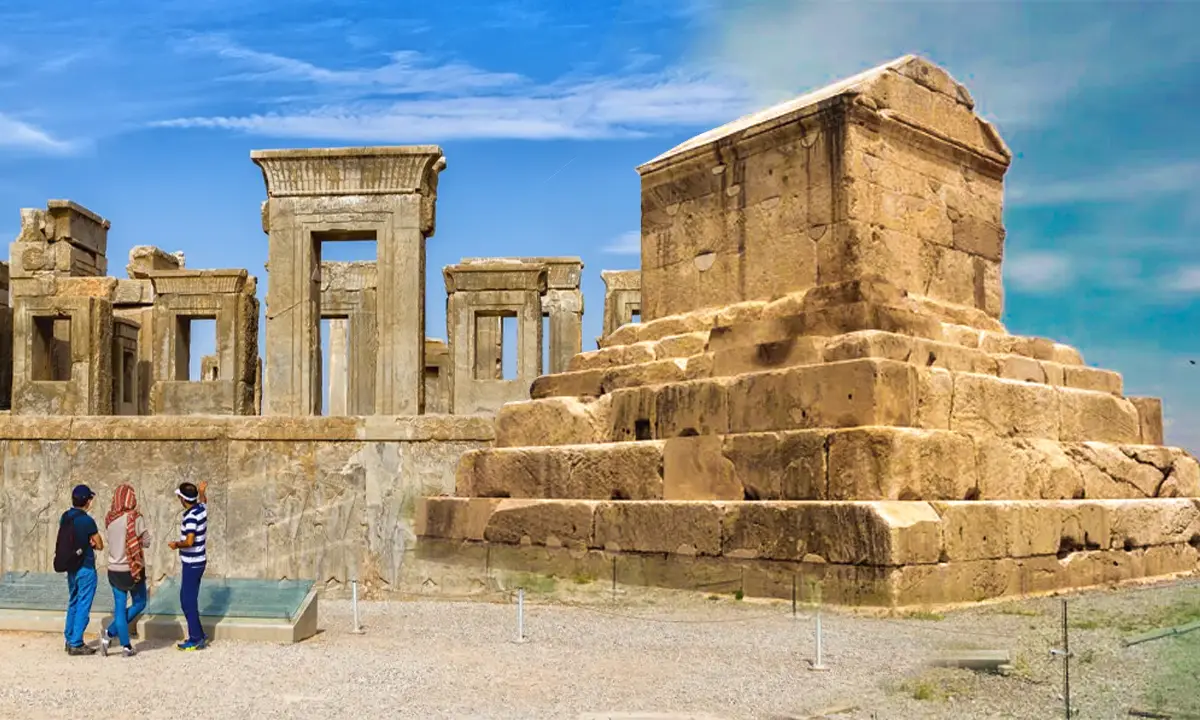Christianity in Iran; most important churches in Iran
![]() Author : asal | Date : Sunday 01 December 2024 15:30
Author : asal | Date : Sunday 01 December 2024 15:30

Christianity in Iran has a rich history, marked by the presence of several important churches around Iran that serve as beacons of faith and history. Among the most important churches in Iran are the Vank Cathedral in Isfahan, renowned for its stunning frescoes and architecture, and St. Thaddeus Monastery, a UNESCO World Heritage site that embodies ancient Christian heritage. These churches, along with others, not only cater to the Christian community in Iran but also attract scholars and tourists intrigued by Iran's diverse cultural tapestry. Christianity in Iran continues to flourish, with these important churches playing a pivotal role in its preservation and growth.
The most important churches in Iran are about:
- Vank Cathedral (Holy Savior Cathedral) in Isfahan
- St. Thaddeus Monastery (Qara Kelisa)
- Saint Stepanos Monastery in Iran
- St. Mary Church (Surp Maryam Asdvadzadzin Church) in Iran
- St. Sarkis Church in Tehran
- Bethlehem Church in Isfahan
- The Cantor Church in Qazvin
Vank Cathedral (Holy Savior Cathedral) in Isfahan
Vank Cathedral, also known as Holy Savior Cathedral, is a cornerstone of Christianity in Iran, located in the Armenian quarter of New Julfa in Isfahan. Established in 1606 and completed in 1664, this cathedral is a testament to the vibrant Armenian community's history and faith within Iran. The architecture of Vank Cathedral is a fascinating blend of Armenian church architecture and Iranian tilework and design, making it a unique cultural and religious site. Its interior walls are adorned with exquisite frescoes depicting scenes from the Bible and the life of Jesus, as well as Armenian religious traditions. The cathedral also houses a museum that displays a rich collection of historical artifacts, including ancient manuscripts, religious texts, and items that narrate the history of the Armenian people in Iran.
Read More:✔️Why visit Iran for your next travel destination?
Vank Cathedral, Uniting Christianity and Armenian Heritage in Iran
Vank Cathedral's significance extends beyond its architectural beauty, serving as a symbol of the enduring presence of Christianity in Iran. It plays a crucial role in the religious life of the Armenian community in Isfahan, hosting regular services and ceremonies in Armenian. The cathedral's museum contributes to its educational role, offering visitors insights into Armenian culture, the history of Christianity in Iran, and the intertwined histories of the Armenian and Iranian peoples.
As one of the most important churches in Iran, Vank Cathedral attracts not only the faithful but also tourists and scholars from around the world, drawn by its rich history, stunning art, and architecture. It stands as a powerful reminder of the diverse religious heritage of Iran, celebrating the country's long-standing tradition of cultural and religious coexistence. Christianity in Iran, with Vank Cathedral at its heart, showcases the country's complex tapestry of faiths and the Armenian community's significant contribution to Iranian society.

St. Thaddeus Monastery (Qara Kelisa)
Nestled in the mountainous region of West Azerbaijan, the St. Thaddeus Monastery, also known as Qara Kelisa, stands as one of the most important churches in Iran, emblematic of the country's rich Christian heritage. Dating back to the early Christian era, legends say the monastery was founded by St. Thaddeus, one of the apostles of Jesus, making it a site of pilgrimage and reverence for centuries.
Heritage and Architecture, Celebrating Christianity in Iran
Recognized by UNESCO for its outstanding universal value, St. Thaddeus Monastery is not only one of the most important churches in Iran but also a masterpiece of Armenian architectural design. Its distinct black and white stone façades, intricate carvings, and ancient murals tell stories of faith, resilience, and artistry across ages. Every year, the monastery becomes a focal point for Armenian Christians, especially during the annual pilgrimage ceremony, which celebrates the apostle's martyrdom, reinforcing its status among the most important churches in Iran.
St. Thaddeus Monastery transcends its spiritual role, acting as a cultural link between Armenian and Iranian communities, reflecting a rich tapestry of shared beliefs and history. This landmark provides a window into Christian architectural evolution in Iran and the resilience of the Armenian identity within the Iranian cultural landscape. As a beacon among the most important churches in Iran, it underscores the nation's embrace of religious diversity. Visitors to St. Thaddeus Monastery are invited into a realm where the heritage of Armenia's culture in Iran is vividly alive, making it a crucial pilgrimage site that celebrates the intricate relationship between history, architecture, and faith, and highlights its significance in the panorama of Christianity in Iran.

Saint Stepanos Monastery in Iran
Perched in the valleys near Jolfa, the Saint Stepanos Monastery is a UNESCO World Heritage site, revered as one of the most important churches aroundin Iran. Its architecture, a testament to Armenian influence, along with its serene setting, marks it as a spiritual and cultural beacon, reflecting Iran's rich heritage of religious diversity.
Bridging Cultures, Saint Stepanos' Role in Iranian Christianity
Saint Stepanos not only stands as a cornerstone of Christian worship but also symbolizes the harmonious blend of Armenian traditions within the Iranian mosaic. Its status among the most important churches in Iran highlights its significance in preserving faith and cultural identity, inviting visitors to explore the intertwined history of religions in Iran.

St. Mary Church (Surp Maryam Asdvadzadzin Church) in Iran
Located in the heart of Urmia, the St. Mary Church, also known as Surp Maryam Asdvadzadzin Church, is one of the oldest and most important churches in Iran. This ancient edifice, believed to have been established in the 4th century, serves as a profound symbol of the Christian faith within the region. It embodies centuries of religious devotion and is a key pillar of the Assyrian community's spiritual life, underscoring its inclusion among the most important churches in Iran.
Read More:✔️UNESCO World Heritage Sites of Iran | Last update 2024
Preserving History and Faith, The Legacy of St. Mary Church in Iran
The architectural integrity and historical significance of St. Mary's Church make it a crucial site for both worship and cultural heritage. As one of the most important churches in Iran, it has withstood the test of time, offering visitors a glimpse into the early Christian era's architectural styles and spiritual traditions. The church's resilience is a reflection of the broader narrative of Christianity's enduring presence in Iran, making it a vital destination for those exploring the rich tapestry of Iranian religious history.
The significance of St. Mary Church extends beyond its ancient walls; it plays an active role in the religious and community life of Urmia's Assyrian Christians today. This enduring relevance cements its status among the most important churches in Iran, attracting scholars, believers, and tourists alike. It stands as a beacon of faith, heritage, and unity, inviting all to witness the legacy of one of Iran's oldest Christian communities.
Through exploring St. Mary Church, visitors engage with a living history that celebrates the diversity and depth of religious expression in Iran. It exemplifies the cultural and spiritual richness that characterizes the most important churches in Iran, offering a window into the past and a bridge to understanding the present.

St. Sarkis Church in Tehran
In the bustling heart of Tehran lies St. Sarkis Church, an emblematic spiritual center for the Armenian community and undeniably one of the most important churches in Iran. Established with a deep sense of devotion and cultural identity, St. Sarkis stands as a testament to the Armenian heritage, its architectural elegance, and the enduring faith that has flourished within Iran's cosmopolitan tapestry.
Spiritual Harmony and Architectural Splendor at St. Sarkis
As a significant landmark among the most important churches in Iran, St. Sarkis Church not only serves the spiritual needs of Tehran's Armenian population but also showcases the intricate beauty of Armenian ecclesiastical architecture. Built-in the 1970s, its presence in Tehran embodies the cultural and religious diversity that characterizes the city, reflecting the harmonious coexistence of different communities. The church’s role in fostering unity and faith underscores its importance among the most important churches in Iran, inviting people of all backgrounds to appreciate its historical and cultural significance.
The church complex, which includes educational and cultural facilities, emphasizes the community's commitment to preserving their rich traditions and sharing them with the broader Iranian society. Through its various programs and services, St. Sarkis Church reinforces its pivotal role among the most important churches in Iran, serving as a center for cultural exchange, religious education, and communal support.
Visiting St. Sarkis Church offers an insight into the vibrant Armenian culture and its integral place within the mosaic of Iranian society. It stands as a proud declaration of faith, identity, and architectural magnificence, marking it as a must-visit destination for those exploring the spiritual landscape and cultural heritage embodied by the most important churches in Iran.

Bethlehem Church in Isfahan
Nestled in Isfahan's Armenian quarter of New Julfa, Bethlehem Church shines as a symbol of Iran's Christian heritage, meriting its status as one of the most important churches in Iran. Built-in the 17th century, its blend of Armenian craftsmanship and Persian culture offers a unique glimpse into the city's diverse past.
A Cultural Beacon in the Heart of Isfahan
Bethlehem Church's significance as one of the most important churches in Iran is evident in its intricate frescoes and Armenian-Persian architecture, drawing global admiration. It stands as a crucial site for the Armenian community, highlighting Isfahan's rich tapestry of cultures and religions.

The Cantor Church in Qazvin
Nestled in a quiet corner of Qazvin, the once-vibrant Cantor Church, also known as the Russian Church, stands as a silent witness to the passage of time and changing tides of faith. Built during the late Qajar era by Russian engineers and staff, this church served as a spiritual home for Orthodox Christian followers amidst the turmoil of World War II. However, with the Russians' departure and the absence of Orthodox followers in Iran, the church ceased its religious functions, gradually transforming into a symbol of the Russian occupation's bitter days.
Today, repurposed as a marketplace for Iranian handicrafts, Cantor Church offers visitors not just a glimpse into its architectural uniqueness, marked by glazed red bricks and distinct geometric forms, but also into a poignant chapter of Qazvin's history. From a place of worship to a historical monument, and now a cultural hub, Cantor Church's journey reflects the resilience and adaptability of heritage in the face of change, preserving its legacy within the heart of Qazvin.

Last Word
Christianity in Iran, with its deep-rooted history and diverse denominations, finds expression through the most important churches scattered across the country. These architectural marvels and places of worship, from the serene St. Thaddeus Monastery to the intricate Vank Cathedral, not only showcase the rich tapestry of Christian heritage in Iran but also stand as beacons of faith and cultural integration. They underscore the nation's mosaic of religious diversity, highlighting the enduring presence and contribution of the Christian community within the broader Iranian society. Exploring these important churches offers insights into the complex interplay of history, religion, and culture that defines Christianity in Iran, inviting both believers and visitors to appreciate the profound depth and beauty of this ancient faith in a land rich with spiritual diversity.
FAQ
What role does Christianity play in Iran?
Christianity holds a significant place in Iran's religious tapestry, representing one of the oldest Christian communities in the world. Despite being a minority, Christians in Iran have contributed greatly to the country's culture and history, with several important churches across Iran serving as key sites of worship and cultural heritage.
Which are some of the most important churches in Iran?
Among the most important churches in Iran are the Vank Cathedral in Isfahan, known for its stunning frescoes; St. Thaddeus Monastery, a UNESCO World Heritage site with ancient origins; and St. Sarkis Cathedral in Tehran, a modern beacon for the Armenian Orthodox community. Each church offers unique insights into the Christian faith and its history in Iran.
Can non-Christian visitors explore these churches?
Yes, most of the important churches around Iran welcome non-Christian visitors, offering a glimpse into the architectural beauty and spiritual traditions of Christianity in Iran. Visitors are advised to respect the customs and dress codes specific to each church.
How does the presence of these churches influence the perception of religious diversity in Iran?
The existence of important churches around Iran highlights the country's long-standing tradition of religious diversity and tolerance. These churches not only serve their respective congregations but also stand as symbols of Iran's rich, multi-religious heritage, fostering a greater understanding and appreciation of different faiths within Iranian society and among international visitors.

.webp)



